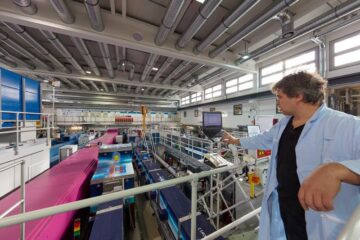Rainforest breathes out

Rivers and swamps may balance carbon books.
The rivers and wetlands of South America’s Amazon rainforest breathe out as much carbon dioxide into the atmosphere each year as the dry regions of the forest absorb, new research shows1.
This suggests that, as a whole, the Amazonian and other tropical forests are in a state of carbon dioxide equilibrium. Because CO2 is an important greenhouse gas, this could help scientists work out how deforestation and industrial activity affect global warming.
„Now that we’ve identified another source of CO2 it makes the whole system appear a little bit more sensitive to disturbance,“ says Jeffrey Richey of the University of Washington in Seattle. Richey’s team sampled water for CO2 over an area of Amazonian wetlands about half the size of Europe (1.8 million square kilometres).
„In some swamp areas you can actually see carbon dioxide bubbling out,“ he says. Bacteria produce the gas as they break down leaves and rotting wood in warm swamps and rivers.
Using a new satellite-based scanning technique, Richey’s team then mapped the extent of Amazonian rivers and swamps at different times of the year. Combining these measurements with CO2 levels in water, they calculated how much CO2 wetlands release.
„The water is a much bigger source of CO2 than we expected,“ says Yadvinder Malhi a carbon-cycle researcher at the University of Edinburgh, UK. Until now its role had been overlooked, he says.
The study does not confirm that the Amazon is truly in carbon equilibrium, as the inputs and outputs over such a large area are difficult to define, warns Eric Sundquist of the US Geological Survey in Woods Hole, Massachusetts. But global measurements of CO2 also suggest that the carbon books balance for tropical forests.
Source or sink
Scientists studying global climate change and how to prevent it require accurate figures for how much CO2 the tropical forests absorb or release.
Deforestation in the tropics is thought to add 1.6 billion tonnes of carbon to the atmosphere each year in the form of CO2; industrial emissions account for about 5 billion tonnes. Amazonian rivers and wetlands contribute around 500 million tonnes of carbon, Richey’s team calculates.
That forests may neither be a source nor a sink for CO2 does not make them irrelevant. If anything, the discovery of the new carbon source suggests that the forest’s contribution to regulating climate is even more crucial than many had suspected.
Human intervention could easily alter water’s role as a carbon source, according to Sundquist. „These processes are particularly susceptible to deforestation,“ he says.
Deforestation increases soil erosion. This could wash more organic matter into rivers and swamps, increasing their carbon output. Or these sediments could trap organic matter so that it doesn’t decompose.
References
- Richey, J. E., Melack, J. M., Aufdenkampe, A.K., Ballester, V.M. & Hess, L.L. Outgassing from Amazonian rivers and wetlands as a large tropical source of atmospheric CO2. Nature, 416, 617 – 620, (2002).
- Grace, J. et al. Carbon dioxide uptake by an undisturbed tropical rainforest in Southwest Amazonia, 1992 to 1993. Science, 270, 778 – 780, (1995).
Media Contact
Alle Nachrichten aus der Kategorie: Ökologie Umwelt- Naturschutz
Dieser Themenkomplex befasst sich primär mit den Wechselbeziehungen zwischen Organismen und den auf sie wirkenden Umweltfaktoren, aber auch im weiteren Sinn zwischen einzelnen unbelebten Umweltfaktoren.
Der innovations report bietet Ihnen interessante Berichte und Artikel, unter anderem zu den Teilbereichen: Klimaschutz, Landschaftsschutzgebiete, Ökosysteme, Naturparks sowie zu Untersuchungen der Leistungsfähigkeit des Naturhaushaltes.
Neueste Beiträge

Bakterien für klimaneutrale Chemikalien der Zukunft
Forschende an der ETH Zürich haben Bakterien im Labor so herangezüchtet, dass sie Methanol effizient verwerten können. Jetzt lässt sich der Stoffwechsel dieser Bakterien anzapfen, um wertvolle Produkte herzustellen, die…

Batterien: Heute die Materialien von morgen modellieren
Welche Faktoren bestimmen, wie schnell sich eine Batterie laden lässt? Dieser und weiteren Fragen gehen Forschende am Karlsruher Institut für Technologie (KIT) mit computergestützten Simulationen nach. Mikrostrukturmodelle tragen dazu bei,…

Porosität von Sedimentgestein mit Neutronen untersucht
Forschung am FRM II zu geologischen Lagerstätten. Dauerhafte unterirdische Lagerung von CO2 Poren so klein wie Bakterien Porenmessung mit Neutronen auf den Nanometer genau Ob Sedimentgesteine fossile Kohlenwasserstoffe speichern können…





















